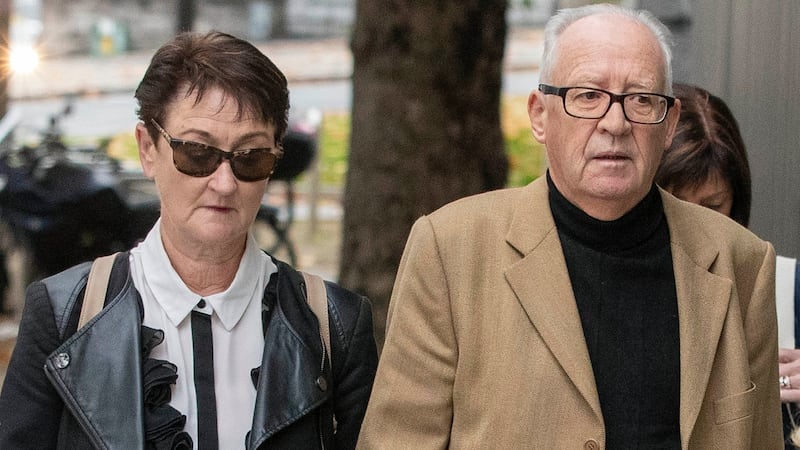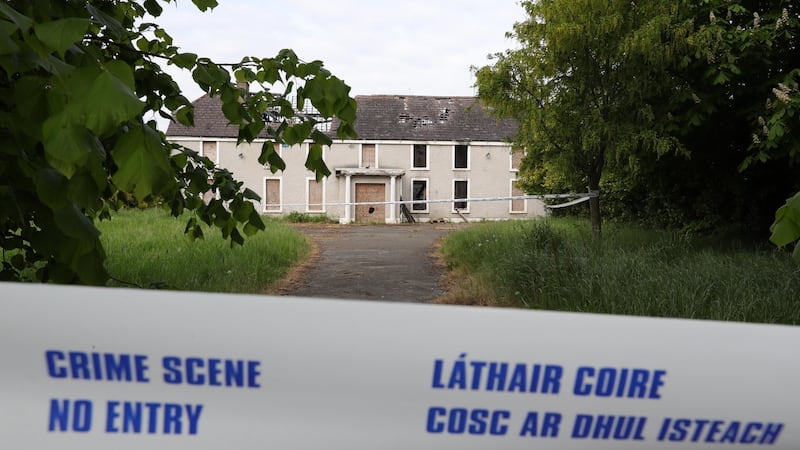We know a huge amount about what happened to Ana Kriégel on May 14th, 2018, both before and during her murder by two 13-year-old boys.
CCTV footage means we know the exact route she took with the teenager known as Boy B as he lured her to the disused farmhouse at the edge of the park.
The science of blood spatter analysis, deployed extensively during the investigation, tells us exactly where she was in the room when she was attacked and what objects were used by the other murderer, known as Boy A, to beat her to death.
Those were vital clues needed to secure the convictions of Ana’s killers. But there are still so many questions, none more so than the question of why Boy A and Boy B decided Ana, an affable, kind 14-year-old girl, should die.
Most other homicides which come before the courts, while tragic, fit into some established type – drug dealers murder rivals in blood feuds; husbands kill wives for the insurance; dissidents plant bombs “for the cause”.

Judges often describe murders as “senseless acts”, but there is usually a motive, however despicable. There is no template, however, for Ana’s murder and, as far as anyone can see, there was no motive.
On the face of it, her killers, both barely out of primary school, come from hardworking, stable families. Neither had been in trouble before. Nor is there evidence that either suffered emotional, or mental problems, or any form of abuse.
In the aftermath of the sentencing of Boy A and Boy B, there will undoubtedly be a rush to find one factor, one defect in society, we can blame for the murder.
Was the vast amount of pornography consumed by Boy A to blame? Was it the violent video games he played? Perhaps social media, and the accompanying bullying endured by Ana, was a factor. What about Boy B’s apparent obsession with weapons?
According to experts who spoke to The Irish Times, there is no one explanation. But there are factors worth examining.
Violent media
It's easy to forget that society has been here before, although perhaps not on this island. Following the murder of James Bulger in Merseyside in 1993 there was a headlong rush in British society to explain why two 10-year-old boys lured a toddler from his mother and left his mutilated body by railway tracks.
For a time, the focus fell on so-called “video nasties”, cheap horror films containing excessive violence which Bulger’s killers were allegedly exposed to. But while the father of one of the killers had rented several of these films, there is no evidence either boy watched them. Merseyside Police later publicly refuted the notion the films played a role.
Fast forward to 2019 and there is ample evidence Boys A and B consumed what might be called the modern equivalent of video nasties – violent computer games. Such games are often blamed – with little evidence it must be said – for the school shootings which now seem to occur on a monthly basis in the United States.
Boy A's interests bordered on the macabre, but so do the interests of many teenage boys, his defence counsel <a class="search" href='javascript:window.parent.actionEventData({$contentId:"7.1213540", $action:"view", $target:"work"})' polopoly:contentid="7.1213540" polopoly:searchtag="tag_person">Patrick Gageby</a> told the trial
However, crucially, there was no evidence these games played a role in the murder of Ana and they were not mentioned in the extensive psychiatrist and psychological reports concerning the boys.
Other media consumed by Boy A was also mentioned in court, including his fondness for horror movies. It may be tempting to focus on these as playing a role but again they were mentioned by the prosecution only in passing.
Boy A's interests bordered on the macabre, but so do the interests of many teenage boys, his defence counsel Patrick Gageby told the trial.
Pornography
Less easy to discount as a factor is the huge amount of, sometimes violent, pornography consumed by Boy A. Gardaí found thousands of images on his digital devices. One featured a man in a balaclava looking at a semi-naked woman, another showed a man choke a woman as a second man watched.
There was also evidence of internet searches for “child porn” and “horse porn”.
While the influence of video games on violence is disputed by experts, there is a growing consensus that unfettered access to extreme pornography from a young age can be highly destructive.
Extreme pornography is giving children a warped view of what normal sexual relationships look like and plays a major factor in many cases of sexual abuse or violence involving children, says Joan Cherry, one of the small number of social workers in Ireland working in the area of juvenile sexual offending.
“Children are increasingly learning about sexuality from the internet and what they’re learning is certainly not healthy.”
The effect can be seen in schools, Cherry says, where teachers are increasingly seeing instances of inappropriate sexual talk and behaviour among children.
“If parents and teachers don’t intervene early, then these issues don’t go away and they will get worse,” she says.
Dublin solicitor Gareth Noble is seeing parents of children as young as 11 come to him for advice because they are worried their child might have committed a sexual offence.
“These are incidents of sexually inappropriate behaviour which might occur in school, which might have been brought to their attention by other parents in the community, or by sports coaches,” he says.
According to Noble, who specialises in child law, access to extreme pornography is at least partly driving this trend as it is giving children “a completely warped view of relationships”.
Many of the cases he deals with can be traced back to internet-delivered material. “I worry, looking at particularly vulnerable children, that their perception between fiction and reality is becoming blurred.
“What we’re finding is young kids, from an early age, and at a very vital stage of their physical and emotional development, are being conditioned by online media to think this kind of stuff is okay.”
Many parents are oblivious to the dangers. “I don’t know if the frequency of sexual assaults has increased but certainly the severity has increased,” Noble adds.
The numbers support him. The best metric available for monitoring youth offending is data from the Garda youth diversion programme. In 2017, it dealt with 20 per cent more child sex offenders than it did in 2016, an increase from 334 to 400. This includes a 37 per cent increase in sexual assault incidents.
The number of child pornography cases rose by 181 per cent, though the vast majority are not child pornography offences in the traditional sense - i.e. the viewing of images of minors for sexual gratification. Instead, they cover the sharing of explicit images between minors consensually, or, more worryingly, as a prank or incident of bullying.
The boy claimed they had a consensual sexual encounter, something which was thoroughly debunked by the evidence in the case
Existing legislation criminalises young people. A better approach, he says, would be to teach teens where the boundaries are: “That means seeing children as potential victims rather than potential perpetrators.”
Returning to Boy A, it is possible and maybe even likely that extreme pornography played a role in the killing of Ana, according to Dr John S Marshall, a Scottish forensic clinical psychologist.
“Access to sexual violence over time means Boy A could have developed what we call deviant interests. He becomes aroused and captivated by that sort of imagery. He would have to then fantasise about acting out about that sort of stuff.”
The final step in the chain, Marshall says, is committing the act in real life.
According to experts who examined Boy A, he does not display a distorted view of sexuality. However they were concerned by the teenager’s account of the sexual attack on Ana. The boy claimed they had a consensual sexual encounter, something which was thoroughly debunked by the evidence in the case, which included Ana’s ripped clothes being scattered around the room.
When asked to describe the attack, he detailed visual elements but left out the emotional aspects, one report said.
Psychopathy
The question of whether Boy A is a psychopath hung over the trial from day one. There seemed few other explanations for why a seemingly normal child, from a stable, loving family, would do the things he did.
There are many types of personality disorder and psychopathy is among the most well known. The most common definitions of the condition include amoral and antisocial behaviour, a lack of ability to feel love, extreme egocentricity, and a failure to learn from experiences.
The reports into Boy A found little evidence of any of these traits, something which surprised Dr Marshall, the Scottish psychologist who specialises in psychopathy.
For Marshall, viewing the case from the outside, Boy A displayed several characteristics which point towards psychopathic traits, not least the teenager’s attraction to violent pornography.
“Sexual deviancy” often goes together with psychopathic traits, he says. “Because you have to be quite cold and callous and lacking in empathy in the first place to show an interest in that type of material.”
When the two combine, he said, it can be “a lethal combination, a perfect storm”.
The “sadistic” nature of the murder also points towards psychopathy, he said. Marshall stressed that he cannot give a fully informed opinion without viewing the full reports. “I can only say sadistic homicide can often correlate with psychopathy traits.”
All of these traits would likely have been tested for in Boy A, using the youth version of the Hare psychopathy checklist. The test involves a list of questions, asked over a 90-minute interview, which are designed to test for things like empathy levels, impulsivity, and a lack of goals. Has the subject ever purposely hurt an animal, have they bullied someone at school and would they be upset if a family member died, are some of the questions put to the interviewee.
Marshall believes there is a general reluctance among child mental health workers to diagnose the condition in minors. Many psychologists argue the word and the diagnosis is so stigmatising as to be counterproductive. Others say psychopathy does not manifest fully until the late teens or even the early twenties.
Dominance
If there are few explanations for Boy A’s actions, there are arguably even less for Boy B’s.
He continues to deny helping to plan Ana’s murder or knowing what Boy A planned to do that day. However, he says he does feel remorse for not stepping in to save her, something he will have to live with “for the rest of his life”, his counsel said.
Nothing sinister was found on Boy B’s digital devices and although he told many lies, these lies were anything but effective. In fact it is highly unlikely Boy B would have been charged if it was not for his own statements to gardaí.
The psychological examinations of Boy B do not show any mental disorder. He is of above average intelligence, comes from a good home, and is unlikely to commit a violent crime in the future, the reports state.

An explanation for his involvement might be found in the many previous cases of killers acting in pairs.
Gregg McCrary, a behavioural criminologist and former FBI criminal profiler, has worked on many such investigations. “Typically there is a dominant offender and then a secondary offender who is subservient and follows their lead. They take direction from the dominant offender,” he says.
Evidence indicates that Boy B was subservient to Boy A. It was Boy A who first proposed killing someone, the trial heard. But it was Boy B who went to Ana’s house and brought her through the park, past many witnesses and CCTV cameras, to the scene of the murder. Boy A was never spotted in her company.
There is also evidence Boy B was and remains in fear of his co-accused. Boy B’s father gave evidence that his son told him he was afraid of Boy A as he had “lots of power”. In the immediate aftermath of their conviction, Boy B cried and pleaded not to be placed in the same cell as Boy A.
More often than not the dominant offender “manipulates or in some way controls their partner to do the things they don’t want to do”, McCrary says. “The secondary person is usually a more compliant personality, someone who just goes along with things.”
During the trial a clinical psychologist retained by Boy B’s defence told the court, in the absence of the jury, that Boy B didn’t want to be Boy A’s friend, and he was somewhat afraid of him. However, he said Boy A could give Boy B some kudos because he was “a little bit different”.
Boy A made Boy B “a bigger presence”, the psychologist said.
Outlier
The murder of Ana Kriégel generated a massive Garda investigation, an eight-week trial and a stack of psychological reports. None of it answers the question of why Ana was murdered on a sunny day in the early summer of 2018.
We may never be able to explain her death. Perhaps it’s a freak occurrence, a “perfect storm” of various factors, and not a sign of something wrong in society.
Solicitor Gareth Noble isn’t so sure. “It’s really, really important we don’t rush to moral panic. But on the other hand we have to understand this has the potential not to be a once-off. And certainly while it appears to be at the most extreme end of things, I’ve seen cases that aren’t far short of it. They could have become this without the right interventions.”
Access to services, like Child and Adolescent Mental Health Services (Camhs), is key, he believes. Noble says he has had parents coming to him, not looking for legal representation, but seeking help for their son or daughter displaying disturbing sexual or violent behaviour.
Indeed, just on Monday the Central Criminal Court sentenced a boy who was 14 when he attempted to murder a woman in Dún Laoghaire. His mother told the court she had tried in vain to get her son inpatient care prior to the attack.
“A lot of it is unchecked, un-met, undiagnosed psychological difficulties.” Ana’s murder “should be a wake-up call”, Noble says.
“We can’t pass it off simply as a once-off.”
















